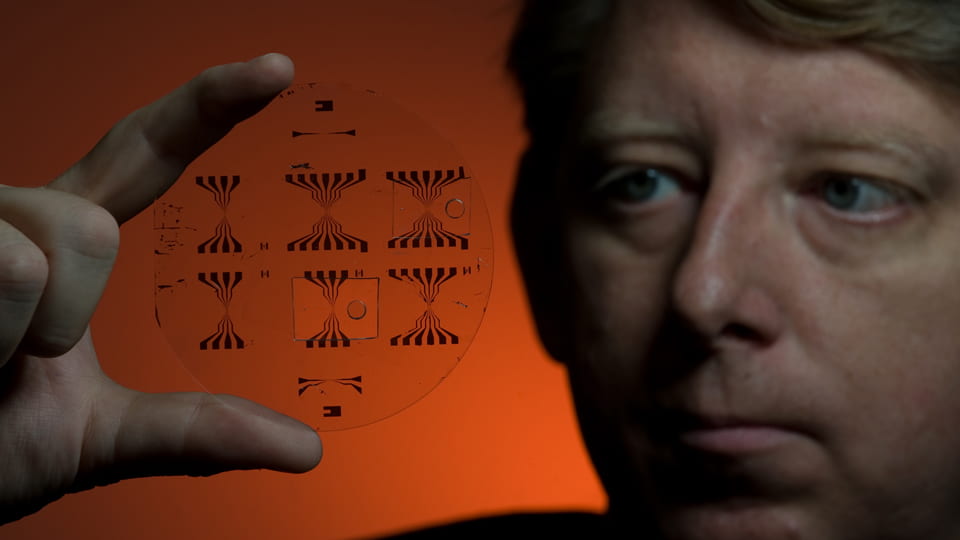Measuring ‘brainstorms’
UCI researchers pioneer technique permitting unprecedented peek inside neurons at activity of ion channels

Like a gathering storm, tiny electrical pulses in a brain cell coalesce into a kind of explosion: the firing of a single neuron.
And the firing of billions of neurons provides each of us with the inner experiences that define our lives – seeing, hearing, thinking, even noting the passage of time between heartbeats.
In a feat of engineering that could extend the reach of both nanotechnology and neurobiology, UC Irvine researchers have found a way to peer inside a neuron and watch as the storm gathers.
Using carbon nanowires only a few atoms thick, the team – led by electrical engineering & computer science professor Peter Burke – managed to eavesdrop on the opening and closing of ion channels at the scale of a single brain cell.
Ions are charged particles that transmit electrical signals. The collective activity of thousands or millions of channels through which they flow is what causes a neuron to fire.
“When it rains, you get a weather report that tells how many inches of rain fell in a given period,” says Burke, whose work was published last month in Scientific Reports. “The weatherman doesn’t measure each drop.”
But the technique his team developed, he says, is the equivalent of “measuring each individual drop of rain.”
That’s a first. “No one has ever measured a single ion channel with a single nanowire before,” Burke says.
The method offers a window into the inner workings of the brain and a brand-new tool for future research.
And it could significantly advance the goals of President Barack Obama’s BRAIN Initiative, announced in 2013, which seeks to map brain functions and attack neurological disorders such as Alzheimer’s, epilepsy and autism.
The team began by creating an artificial cell. Its wall, like that of a real cell, is pockmarked with pores that open and close, allowing ions to flow in and out.
Next, the scientists installed nanowires just outside the artificial cell’s wall. The wires are capable of registering minuscule fluxes of energy and picked up the pelting of “raindrops” – in this case, the size of atoms – signaling the opening and closing of ion channels.
For now, the nanowire detector is confined to its carefully constructed laboratory setting. Asked to speculate, however, Burke sees a number of potentially revolutionary applications in the years and decades ahead.
A nanowire detector, for example, could be implanted in a living human brain, perhaps providing therapy for brain disorders or simply monitoring the organ itself and learning the submicroscopic details of information traffic among brain cells.
No one has yet developed a way to implant such a device, Burke notes, and doing so might be difficult. One possible avenue: attach the detector to a free-floating “nano radio” that could broadcast data about the state of ion channels.
“So many processes in life, in biology, are using electricity,” Burke says. “The cell, in a sense, is converting some physical phenomenon into an electrical signal. It all involves these ion channels.”
All our senses, from vision to smell, rely on these channels, he says, adding that in the future “you could have an artificial nose, an artificial eye.”
Electricity is critical to coordinate the beating of our hearts and other life-or-death bodily functions, such as the release of insulin in response to sugar in the blood. So the new detectors could, for instance, lead to a better understanding of diabetes.
And the ability to spy on ion channel activity could prove invaluable for cancer researchers. “You could use this technique to measure how chemotherapy affects cell death or to figure out why cancer cells don’t die,” Burke says.
Another important potential use is in drug screening. Fifteen percent of all pharmaceuticals act on ion channels; knowing how they do it could greatly improve the reliability of testing to ensure a drug’s safety and effectiveness.
“This wire, a few atoms across, is sensitive enough to measure with unprecedented resolution the way neurons work,” Burke says.
The study’s lead author is Weiwei Zhou, and co-authors are Yung Yu Wang, Tae-Sun Lim, Ted Pham and Dheeraj Jain.